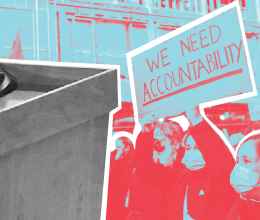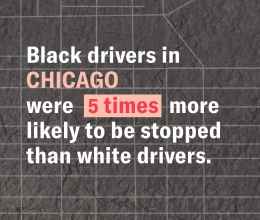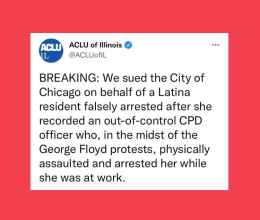
The evidence is clear: police officers have no place in public schools. In Chicago, more than 200 Chicago Police officers are assigned to the so-called “School Resource Officer” program. But rather than providing “resources” to students, this $33,000,000 program staffs police at predominantly Black and brown schools —police who have been shown to abuse and criminalize young people of color, including when kids are just acting like kids.
Police do not provide school “resources” when they shove a child down the stairs and drag her through her school halls, or when they Taser and beat children with batons for violating school rules regarding cell phones. The harm to students who experience police abuse in their schools – where they should feel safe and ready to learn – is simply enormous. Police in schools harm the entire school community. Students fear they could be the next person abused and harmed by police. And to make matters worse, even police officers with sustained civilian complaints against them and those who have repeatedly used force against children are staffed in our schools. Let that sink in. Police who have hurt kids are in schools throughout our City every day.
For all of these reasons, staffing school with police officers creates an environment that is not conducive to learning, development, or the safety they are ostensibly there to provide.
Chicago’s use of police in schools reflects a bigger City problem: our leaders’ consistent choice to prioritize policing over other resources for Chicago’s schools. For many years, youth, advocates, and teachers in Chicago have been calling for the City to make a different choice. Those rallying cries have reached a fever pitch in response to the continued killings of Black and brown people by police.
Black students and students with disabilities are disproportionately impacted by police being staffed in CPS schools. Black students in CPS are four times more likely to be subject to a Police Notification compared to white students in CPS. Students with disabilities make up only 15% of the CPS student body, but are the target of 30% of police incidents in schools. In a school system that primarily serves Black and brown students, the City’s leaders must respond to the youth’s demands not with political gamesmanship, but with a real vision toward ending the School Resource Officer program and providing our students with the developmentally-appropriate resources they deserve.
Mayor Lori Lightfoot and Chicago Public Schools Superintendent Janice Jackson both have stated that they intend to continue the agreement setting out the police-in-schools program. They claim that they want to give Local School Councils (LSCs) the power to decide whether or not an individual school will have a police officer on staff. But their focus on “local interests” fails to acknowledge that the City is responsible for ensuring the safety and security of its students. The LSCs are not legally liable for officer abuse and misconduct within schools – that liability rests with the City. And critically, the City retains most other decisions regarding safety policies. For example, the City would never allow an LSC to decide that students and teachers should be allowed to bring weapons to school. This issue is no different.
The City’s insistence that the removal of police from schools is decision for the LSCs must be called out for what it is – a political diversion tactic to avoid high level accountability for the harm to students from having police in schools. The Mayor, the Board of Education, and the City Council are attempting to avoid the political pressure of the current moment by passing the buck toward less accountable and less well-known bodies. But the LSCs are not able to decide whether they would like to staff a police officer, a counselor, a psychologist, or a social worker in their schools. They are not presented with the option of developmentally-appropriate resources to mentor students and mediate conflicts. In fact, the City has deprioritized those resources: In the 2017-2018 school year, Chicago Public Schools employed one psychologist per 1,760 students and one social worker per 1,238 students. CPS experiences similar shortages with regard to counselors, librarians, and nurses. As a result, rather than being presented with options, the LSCs are given an officer-or-nothing choice from the Board and City Hall. That is not local control. That is “take it or leave it.” The City has effectively abandoned its underserved school communities, and is now feigning concern over local control in the wake of political pressure.
In her second Monitoring Report, the Monitor overseeing the CPD Consent Decree noted that CPD and CPS have failed to reform the police-in-schools program. In particular, CPD has failed to appropriately collaborate with CPS in selecting the police staffed at schools, and has failed to adopt appropriate selection criteria (including the Monitor’s repeated call to adopt an “excellent” disciplinary history requirement for police seeking to be staffed in schools). But even if the City adopted stronger selection criteria for police in schools, the data they’d be pulling from would be incomplete: as the DOJ noted in its 2017 report, very few complaints against police are sustained through our current investigatory bodies, and there are massive barriers to even filing a complaint in the first place.
The Consent Decree is a mandatory court order signed by a federal judge, and the CPD has missed more than 70% of deadlines. These missed deadlines are not just related to the police-in-schools program itself, but also related aspects of policing that make their way into the schoolhouse when police officers are brought on staff: CPD has failed to comply with court-ordered use of force reforms, accountability and transparency improvements, and officer wellness programs. Our City has a duty to keep students safe, and staffing Chicago Police Officers in schools is a dereliction of that duty. Our political leaders must take bold and decisive action now to end this program and appropriately support schools with actual resources.



